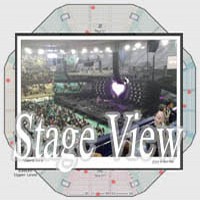Nippon Budokan
Nippon Budokan (or simply Budokan) is the most popular arena in Japan. Nippon Budoukan was built for Judo competition venue in the Tokyo Olympic, 1964 summer. The first musician played the concert at Nippon Budokan is The Beatles, in June 30, 1966.
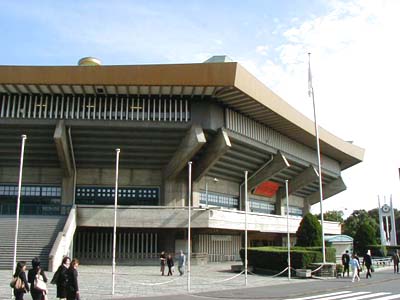
1. Direction
(1) To Kudanshita station
The nearest station to Nippon Budokan is Kudanshita station on the Tozai Line, Hanzomon Line, and Toei Shinjuku Line (These line are subway).
The directions from major stations exlained below:
- From Tokyo station : Take Marunouchi Line bound for Ikebukuro. Change at Otemachi station (the next station of Tokyo) to Tozai Line bound for Nakano or Mitaka, or Hanzomon Line bound for Shibuya. Kudanshita is the second station.
Alternatively, you can take a taxi at Marunouchi Gate of Tokyo station. The fare is about 1,000-1,500 yen, and it takes 10-15 minutes. - From Shinagawa station : Take JR Yamanote Line bound for Shinjuku, Shibuya. Change at Shibuya station to Hanzomon Line bound for Oshiage or Kuki. Kudanshita is the fifth station.
This page is official Tokyo Subway map.
(2) To Budokan from Kudanshita station
Arriving Kudanshita station, you will go out of Exit No.2. You will go straight, so you can arrive Budokan about 3-5 minutes by foot.
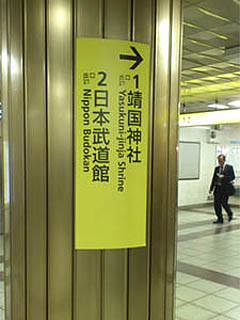
In station, you can follow the information board.
The ticket scalpers are usually around the entrance gate of Budokan. If you don't have tickets, you can try to negotiate with them. (* But, they can't almost certainly speak English.)
2. Seating charts guide
There are three sections, Arena seats (Floor level), First floor of stands (Lower level), and Second floor of stands (Upper level) in Budokan. Budokan is octagon shape, so the stands are divided 8 sections and named for directions, such as "North" "Northeast" "East" "Southeast" "South" "Southwest" "West" and "Northwest". Usually, the stage is constructed on the North side.
Below is the general layout of seat. You can check where is your seat in this chart and stage view from your seat.
In above charts, Upper level looks rearer than Lower level, but actually it's not true. Actually, Upper level overlaps Lower level. You can see the position relation of these seats level in below images.
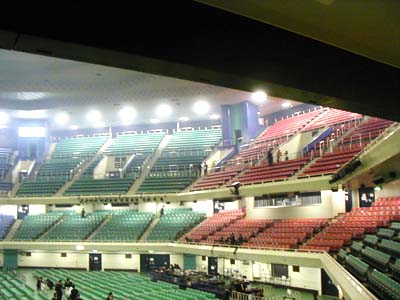
It's taken from West section of Lower level.
(1) Floor level
In Floor level, the seats are divided into 10 blocks horizonally and 3 blocks vertically usually.
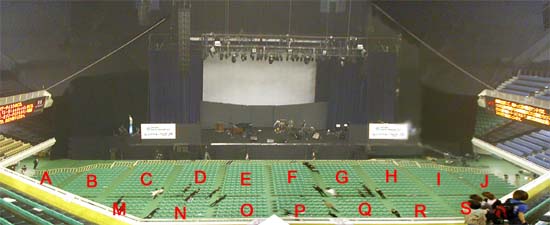
An example of blocks
These seat blocks have 8 seats in a row usually.
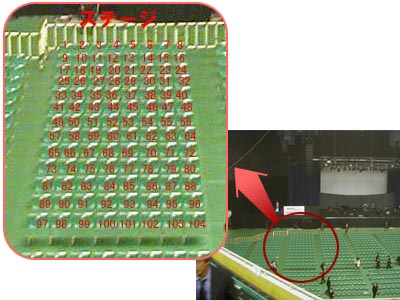
An example of seat number
The image above are just examples. Details are different each concert. But, these are five types of the block name. Here list these types.
(a) Type of A, B, C...
This type is the most popular of blocks name.
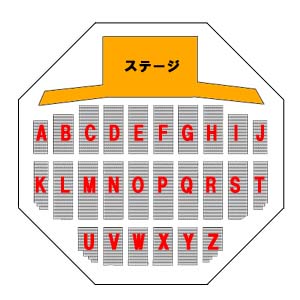
An example of block name of this type (a)
(b) Type of A1, A2, A3...
This is the type of blocks name as popular (a) type.
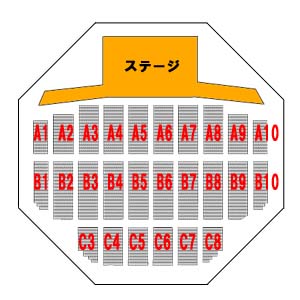
An example of block name of this type (b)
(c) Type of A1, B1, C1...
This is a similar name of type (b), but this type is used less often type (b).
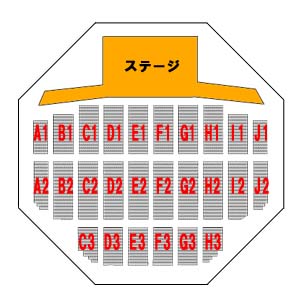
An example of block name of this type (c)
(d) Type of row and culmun number
This type is rare case. In this case, there are about 40 rows, and about 80 seats be in the widest row.
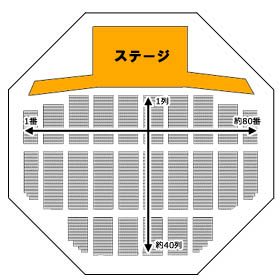
An example of block name of this type (d)
(e) Type of standing only
This type is used for the floor level as standing only. In this case, you need to be in the block as decribed in your ticket.
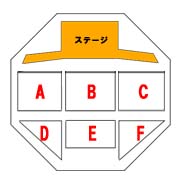
An example of block name of this type (e)
(2) Lower level (IKKAI Stand SEKI)
Lower level are located around Floor level. 8 sections are in Lower level named as azimath.
One section includes rows A-K. There isn't Row I, because maybe "I" is often misread as "1" (one). In row A, there are number 7-42 seats, and in row J, there are number 1-48. Only row K is different layout.
Usually, 5 sections - East, Southeast, South, Southwest, and West - are used only. The sections of Lower level are same layout of seats with the exception of South section. There are not row G-K in the center (number 13 through 36) of South section.

The seating chart of a section of Lower level.
The seat of Lower level have a low ceiling. If you are tall, you might not stand in the back rows. (row H, row, J and row K...)
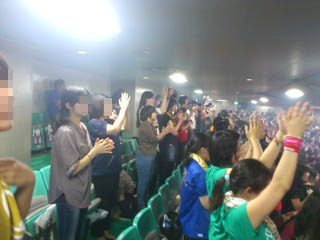
The back rows of Lower level
As to row K, row K located posterior to the passage, and the ceiling over the row K is low in particular. I think this row is one of the worst seat in Budokan.
Below is the stage view from row K. The ceiling obstruct the upper half of your view...
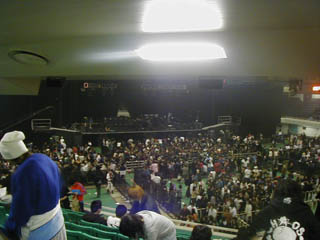
As to other sections, North, Northeast, and Northwest, these sections are rarely used. Because these sections are located the back of stage.
If you are in these sections, you will see the back of artist for the most concert. But, if artist looks back, you can see him/her nearer than row 1 of Floor level.
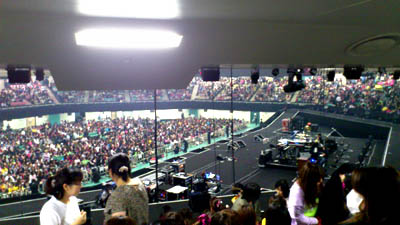
The stave view from Northeast
(3) Upper level (NIKAI Stand SEKI)
Upper level are located over the Lower level. 8 sections are in Upper level as same as Lower level.
One section include rows A-X. There isn't Row I and Row O. In row A, there are number 12-49 seats, and in row X, there are number 1-60. There are standing space in the back of row X.
In upper level, 8 sections are similar layout. But, in East and West sections, there are not row A. So, the front row is B.
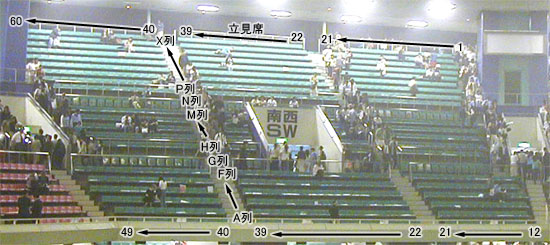
The seating chart of a section of Upper level.
In Upper level, there are three passeges, the back of row F, row M, and row X. The seats are located on side these passage, except for row X.
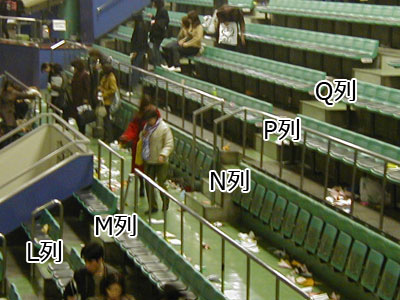
The passege in the back of row M. The passage of row F is similar layout.
The standing space, in the back of row X, is used passage usually. You may see stage hardly.
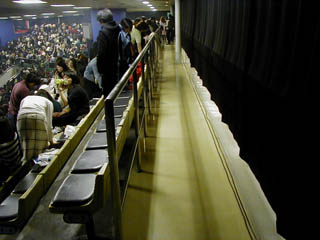
Row X (left) and standing space
Below images are stage view from each section.
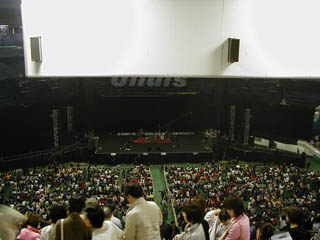
Stage view from South.
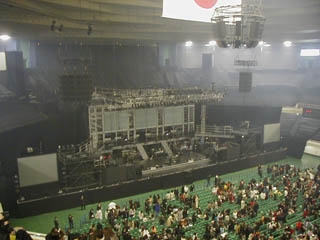
stage view from Southwest.
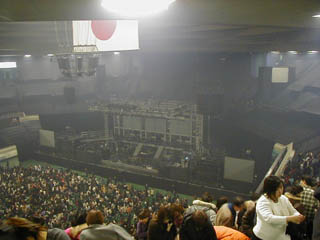
stage view from Southeast.
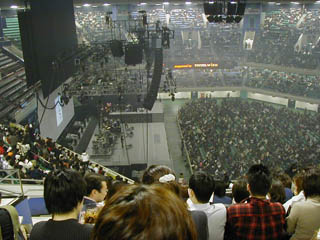
stage view from West.

stage view from East.
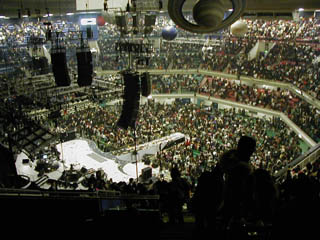
stage view from Northwest.
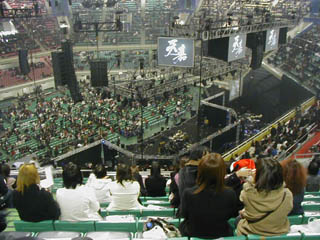
stage view from Northeast.
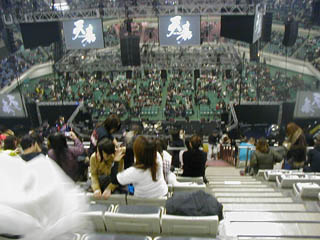
Stage view from North.
3. Information
| Capacity | 14,201 (Floor level:2,762, Lower level:3,199, Upper level:7,760, Standing:480) |
|---|---|
| Address | 2-3 Kitanomaru-Koen, Chiyoda-ku, Tokyo, Japan |
| Tel | +81-3-3216-5100 |
| Official Website | http://www.nipponbudokan.or.jp/ (Japanese version only) |



